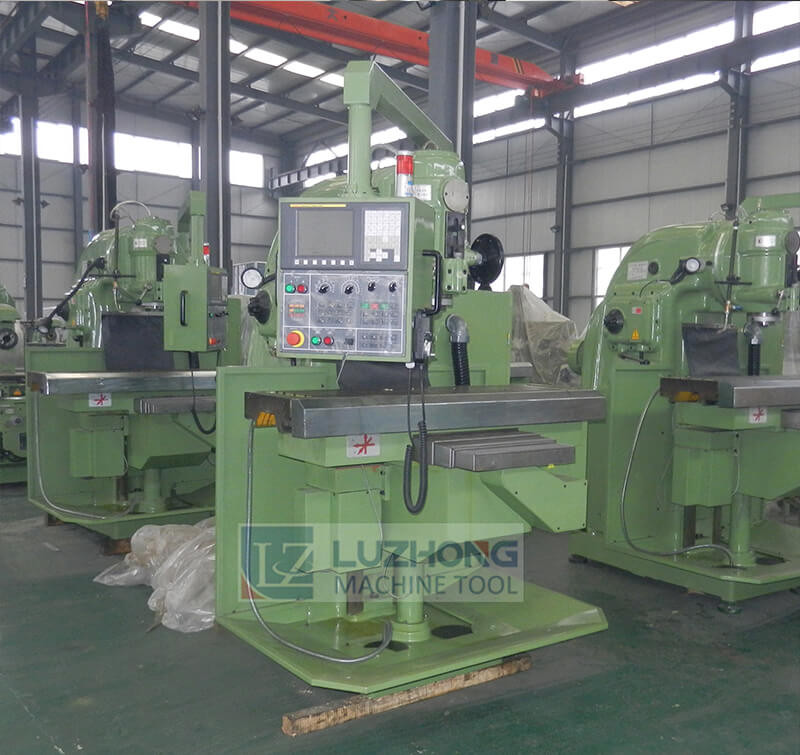Forward and reverse milling
First: The rotation direction of the contact part between the milling cutter and the workpiece is the same as the feeding direction of the workpiece, is forward milling, Otherwise, it is reverse milling. There is always a large or small gap between the nut and the screw of a small CNC milling machine. When the horizontal milling component changes during down milling, the table and the screw will move left and right. This kind of periodic movement makes the table movement very unstable, which may easily cause the cutter teeth to be damaged. However, the vertical milling component of the down milling presses the workpiece against the table, the cutter teeth slide against the machined surface, and the friction is small. Tooth wear, reduced work hardening, and reduced surface roughness are all beneficial. Therefore, when the clearance between the table screw and the nut is adjusted to less than 0.03mm or when milling thin and long workpieces, down milling should be used. During reverse milling, the vertical component of milling lifts the workpiece, and the friction between the cutter teeth and the machined surface increases. However, the horizontal component force during milling helps the lead screw and the nut to be in close contact, which makes the table movement more stable, and the wear of the cutter teeth caused by milling cast and forged parts is also small. Therefore, up milling is generally used for up milling.

CNC Milling Machine
Second, the characteristics of up and down milling in CNC milling machines
Features of down milling:
During down milling, the cutting thickness of each cutter gradually changes from small to large. When the teeth just contact the workpiece, the cutting thickness is zero. Only when the teeth slide a certain distance on the cutting surface left by the previous teeth and the cutting thickness reaches a certain value, the teeth really start cutting. Down milling makes the cutting thickness gradually change from large to small, and the sliding distance of the cutter teeth on the cutting surface is also very small. Moreover, the distance of the cutter teeth on the workpiece during the down milling is shorter than that of the up milling. Therefore, under the same cutting conditions, the tool is prone to wear when using down milling. During down milling, the cutter teeth are cut from the workpiece surface each time, so it is not suitable for machining hard-skinned workpieces. The average cutting thickness during down milling is large, the cutting deformation is small, and the power consumption is less than that of up milling.
Features of down milling:
During down milling, the cutting thickness of each cutter gradually changes from small to large. When the teeth just contact the workpiece, the cutting thickness is zero. Only when the teeth slide a certain distance on the cutting surface left by the previous teeth and the cutting thickness reaches a certain value, the teeth really start cutting. Down milling makes the cutting thickness gradually change from large to small, and the sliding distance of the cutter teeth on the cutting surface is also very small. Moreover, the distance of the cutter teeth on the workpiece during the down milling is shorter than that of the up milling. Therefore, under the same cutting conditions, the tool is prone to wear when using down milling. During down milling, the cutter teeth are cut from the workpiece surface each time, so it is not suitable for machining hard-skinned workpieces. The average cutting thickness during down milling is large, the cutting deformation is small, and the power consumption is less than that of up milling.
Features of upside down milling:
Because the direction of the horizontal cutting force acting on the workpiece by the milling cutter is opposite to the feed movement direction of the workpiece, the table screw and nut can always keep one side of the thread tightly fit. This is not the case with down milling. Because the direction of the horizontal milling force is consistent with the workpiece feed movement direction, when the force of the cutter teeth on the workpiece is large, due to the existence of the gap between the table screw and the nut, the table will produce channeling This not only destroys the smoothness of the cutting process and affects the machining quality of the workpiece, but also damages the tool in severe cases. Due to the large friction between the cutter teeth and the workpiece, the coldness of the machined surface is more serious.
Summary: Down milling and down milling have their own advantages and disadvantages. Which milling method is used depends on the requirements of the workpiece being processed. If high surface smoothness is required, then down milling is used, otherwise reverse milling is used.
Copyright © Shandong Luzhong Machine Tool Co.,Ltd. All Rights Reserved